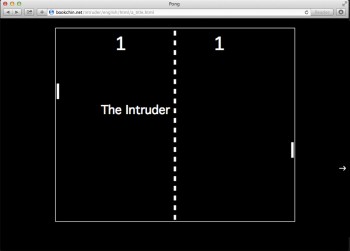A brilliant adaptation of a brutal Borges short story
—New York Times
The finest example is Natalie Bookchin’s The Intruder. A ‘tale told in ten games’, The Intruder is an interactive narrative based on a story by Jorge Luis Borges. The viewer must compete in some rudimentary games to hear, read and see the story. Thoroughly well-observed, and compelling, The Intruder takes about 15 minutes to navigate. The games are not difficult but act as an aid to the narrative and introduce levels of addiction to the telling of the story.
—The Guardian Web Watch
In Natalie Bookchin’s piece, The Intruder, we are presented with a sequence of ten videogames, most of which are adapted from classics such as Pong and Space Invaders. We interact via moving or clicking the mouse, and by making whateve we make of/with/from the story. Meaning is always constructed, never on a plate. The interaction is less focused on videogame play than it is on advancing the narrative of the story we hear throughout the presentation of the ten games. The story is the Jorge Louis Borges piece The Intruder with a few changes. The female in the story is “the intruder” She is as a possession of the two closely bonded miscreant brothers enmeshed in a hopeless triangle of psycho-sexual possession with homoerotic undertones. Finally one of them kills her to end the tension between the two men. Game over. Story over. Bookchin presents an awareness of being an intruder, herself, in the (previously?) male-dominated world of videogame creation and enjoyment. The videogame paradigms are subverted, mocked, and implicitly criticized for their shallow competitive and violent nature not unrelated to the nature of the violence of the males.
Although moving and clicking the mouse is associated with advancing the videogames, the videogames are subordinated to the story; the videogames are used as and within literary devices. The videogames are literary devices in that they are programmed machines functioning less to advance gameplay as triggers for the advancement of the audio of the story. The videogames are also functioning within other comparative/metaphoric literary devices. We compare the worlds of the games with the worlds of the story. We compare ourselves in the world of the games with ourselves in the world of the story, i.e., we compare the goals of the games with our goals in reading/listening to and understanding the stories. We cannot enjoy the games in the way that videogames are meant to be enjoyed [….]The artist mops the floor with the videogames. Art 10. Videogames 0. Women cheer this artwork like few other Net-based works. It is deservedly famous both as statement and for its formal literary innovation.
—Andy Clarke, Grethe Mitchell, Videogames and Art
In Natalie Bookchin’s “The Intruder,”, a short fiction of that name by Jorge Luis Borges is made into a series of ten computer games, with Borges’s text appearing in rollovers and voiceovers as rewards for “winning” the games. Borges’s text, with the subtle irony typical of him, presents a misogynistic scenario in which two brothers first court, then share a woman between them. Finding that her presence leads them to quarrel, they cart her off to a whorehouse, only to discover that each brother secretly visits her there, so they haul her home again to save money. The understated climax arrives when one brother informs the other he has killed the woman, thus uniting the two brothers forever in guilt and silence, a bond cemented by the imperative to forget. In one of Bookchin’s games, the object is to bounce a female figure back and forth between two paddles, thus making the user complicit in the story’s plot. Another darkly funny game presents the user with two buttock-like circles with a hole between them, from which fall objects associated with the woman, which the user tries to catch by moving a virtual bucket. Because the games compel the user to enter dynamically into the production of text, they serve to connect the user in surprisingly powerful ways to the narrative; I found myself more engaged with Bookchin’s deliberately kitschy games than with Borges’s satirical tale, which is dark enough to make most readers feel emotionally distanced from its brutal plot.
—N Katherine Hayes (excerpt from Commentary Memmott)

